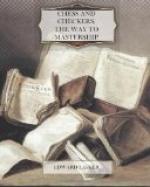32 31 30 +---------------------------------------+ | | | | | | | | | 29 |---------------------------------------| 28 | | | | | | | | | |---------------------------------------| | | | | | | | | | 21 |---------------------------------------| 20 | | | | | | | | | |---------------------------------------| | | | | | | oo | | | 13 |---------------------------------------| 12 | o | | oo | | oo | | | | |---------------------------------------| | | | | | | | | | 5 |---------------------------------------| 4 | | | * | | ** | | ** | | +---------------------------------------+ 3 2 1
Diagram101.—White to Move and Win.
him in check without being impaired in his effectiveness towards the center of the board. If Black had the move, White could not win at all, as he would be unable to dislodge Black’s Kings. As it is, he wins by means of a sacrifice which often occurs in endings with 4 Kings against 3.
Black White
(1) ... 14-9 (2) 1-5 9-13 (3) 5-1 11-15 (4) 2-6 10-14 (5) 1-5 15-18 (6) 5-1
32 31 30 +---------------------------------------+ | | | | | | | | | 29 |---------------------------------------| 28 | | | | | | | | | |---------------------------------------| | | | | | | | | | 21 |---------------------------------------| 20 | | | | | oo | | | | |---------------------------------------| | | | | | | oo | | oo | 13 |---------------------------------------| 12 | o | | | | | | | | |---------------------------------------| | | | | | | ** | | | 5 |---------------------------------------| 4 | | | * | | | | ** | | +---------------------------------------+ 3 2 1
Diagram 102.
It would not help Black to play 6-2 on account of 13-9; (7) 5-1, 9-5; (8) 2-6, 14-17; (9) 6-2, 17-13; (10) 2-6, 18-15; (11) 6-2, 15-10, etc.
(6) ... 14-9 (7) 6-2 9-5 (8) 2-6 18-15 (9) 6-2 15-10
This is the important move, which forces the win.
(10) 2-6
If 2-7, White exchanges by 13-9
(10) ... 10-7
Only with this pretty sacrifice can White win the game. After (11) 3-10 White plays 5-9 and should Black answer (12) 6-2, White would get “two for one” by 9-6. Therefore, Black can do no better than play (12) 10-15, 9-2; (13) 15-19, etc., and get a King in each double corner. White then wins as explained in the chapter on elementary endings.
Fourth position results in a draw only when the man is held on 12 or 21, according to whether the weaker side is Black or White. In third position it is useless to hold the man on the above squares, but sometimes a draw is obtained by holding him on 20 or 13.




